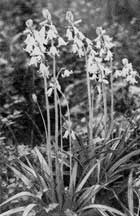Bulbs From Spring to Fall, Page 2
By VICTOR H. RIES
Nature Magazine, September 1937
Page 1 | Page 2
We have mentioned grape hyacinths. Once you try them or even see them you will always want them. Using not only the early Muscari botryoides, but the later variety, Heavenly Blue, which blooms two to three weeks later, you can have these charming little flowers in bloom for a month or so in your garden. There are a number of other varieties worth growing, as well.
Now we come to the tulips. One of the earliest in bloom is the Kaufman tulip, one of the wild species. It blooms at the same time as the earlier flowering daffodils or narcissus.
A few varieties that you will especially enjoy are Alasnam, Queen of Spain, Thallia, John Evelyn, Nellie O'Melvie, Laurens Koster, Mrs. Krelage, Bath's Flame, Spring Glory, Diana Kiasner, Will Scarlett, Early Surprise, Cheerfulness, Lucifer, Bernadino, Lord Kitchener, and Twink. Or, if you want a pink trumpet, you may save up for a Mrs. Backhouse. Most of these you will want to plant where you can see them at close range. They may be among the perennials or in a bed by themselves, to be planted later to annuals, or hardy chrysanthemums that you expect to dig and store over winter in a cold frame.
Buy a selection of early flowering and late flowering varieties of narcissus. They will bloom in from four to six weeks.
Do you, by the way, know the difference between narcissus, daffodil and jonquil? Narcissus is the scientific name of the genus. Daffodil is the common name. All narcissuses are daffodils and vice versa. Jonquils are one particular kind of narcissus or daffodil. They have several small yellow flowers to a stem and a narrow, more or less grass-like leaf, whereas other forms of narcissus have a flat strap-like leaf. And yet most of our florists incorrectly call all narcissuses jonquils.
And then come the tulips overlapping the narcissuses.
First the early flowering varieties that for some reason are too often overlooked, especially the singles. The doubles are not as satisfactory since their short stems do not keep them above the splash of mud.
Everyone knows and enjoys the Darwin tulips. Some prefer planting them in patches of one variety-others prefer the mosaic of a mixture. Both types of planting are excellent if we will mass them in groups of twelve or more rather than planting them in a single row along the edge of a bed.

SPANISH BLUEBELL
The new "Ideal" tulips give us a new range of colors, a new shape of flower, and the price is coming down to the point where we can all afford to have them. The old parrot tulips, with their floppy flowers and weak stems, are now replaced by the new "fantasy" varieties and others. You will like them. The Breeder tulip gives us a different range of color from the Darwins, but blooms at the same time as do the cottage tulips with their long slender buds.
About the same time another of the squills, Scilla nutans, comes into bloom, resembling a loose flowered hyacinth. Its white, pink or blue flowers give it a wide variety of uses in all parts of the garden, sun or shade, where they usually multiply. They are equally desirable as cut flowers.
And so, on to the lilies. They are a story in themselves, with most of us knowing but a few of the common ones. Why not look up one of the books on lilies such as Mrs. Fox's Garden Cinderellas, Isabella Preston's Garden Lilies, or Marshall's Consider the Lilies. You will immediately start looking for places to plant them. Many lilies are easy to grow; a few, like the Madonna, may be easy though it is not always so. Some, like Lilium speciosum and auratum, give excellent results for a season or so, but often disappear.
Among the most reliable are L. elegans, umbellatum, and L. tigrinum. They will grow anywhere and multiply. Others you should have no difficulty with are L. regale, L. hansoni, L. henryi, L. con color, and L. superbum. But try them out for yourself, being sure to follow the instructions as to depth of planting and drainage. They vary in their requirements, depending on the variety. Incidentally, many prefer to get native grown bulbs with roots rather than Japanese grown ones. This is not always possible, however.
Lilies will give us blooms averaging two weeks apiece from early June to September.
For additional summer bloom you can use any of the following tender bulbs: summer hyacinth, hardy amaryllis, Zephranthes, Tigridia, Montbretia and others.
For late summer bloom nothing is nicer than the hardy begonia, Begonia evansiana.
And finally we will finish the season with our late planted gladiolus, which, if planted in late June, will bloom during late September until frosts kill them. Although sometimes a gamble, it is one well worth taking.
One point we have not considered is the necessity of using all the spring flowering bulbs in connection with some other plant-ing since their own foliage dies down and disappears by July 1.
The lilies, on the other hand, keep their foliage throughout the season, although with the exception of a few varieties, it is seldom sufficient to make an attractive effect. The various daylilies, Hemerocallis, especially the new summer flowering varieties such as Baystate, Hyperion, Crawford, Sir Michael Foster, Ophir and others make an excellent combination with the hardy lilies.
If you would delve further into the field of bulbs you will enjoy Mrs. Louise Beebe Wilder's latest book Adventures with Hardy Bulbs.
The new crop of bulb catalogs is out. Start perusing them now so you can place your bulb order for early fall delivery.
Page 1 | Page 2
 Printer-friendly version
Printer-friendly version
